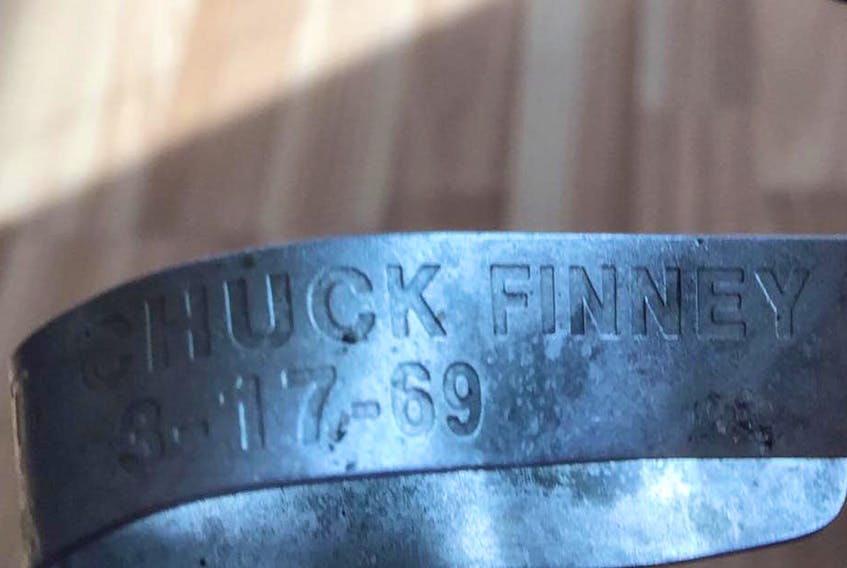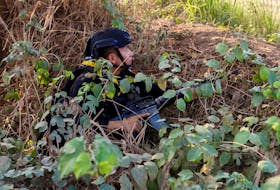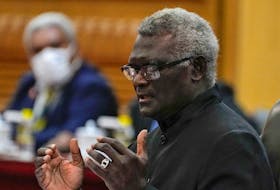METEGHAN, N.S. – Louisette Saulnier and her sister Odette Thibodeau often walk the beach in Meteghan, Digby County, N.S. looking for beach glass.
Saulnier has found lots of pieces, but a recent find of another sort was even more interesting she says.

“It was semi-buried. It was half sticking out and I just grabbed at it,” says Saulnier.
What she pulled from the sand was a bracelet with the inscription: Capt. Chuck Finney 3-17-1969.
“We go pick up beach glass. Every now and then I find the odd button, or the odd piece of something, and I found that,” she says. “It struck me, ‘Oh, there’s a name on it.’”
“At first I thought it was some sort of fishing piece, from a lobster fishermen’s boat, but then there was a name on it,” Saulnier says.
Her curiosity was piqued by the inscription on the bracelet.
“We took our cellphones out and Googled it right away,” she says.
Her story also piqued the curiosity of the Tri-County Vanguard.
Who was Capt. Chuck Finney?

Capt. Charles ‘Chuck’ Finney, born in 1944, served in the Marine Corps as a bombardier/navigator during the Vietnam War.
According to the United States Department of Defense, on March 17, 1969, he was flying in an A-6A aircraft on a night armed reconnaissance mission over Laos. Crewmen from other aircraft in the area observed an explosion in the vicinity of a target, then a second explosion nearby believed to be that of Finney's aircraft. There were no parachutes sighted and no emergency beepers were heard. Search and rescue efforts were terminated several days later when no signs of survivors were found.
And so Capt. Finney, just 24 years old, was listed as MIA – missing in action – as of 3-17-1969, the date on the bracelet that Saulnier found.
In April 1978 his status was changed from MIA to KIA, killed in action.
Posthumously Capt. Finney was also promoted to a Major.
FINDING FINNEY
The U.S. Department of Defense says in 1995 and 1999, a joint U.S.-Laos team interviewed local villagers in the area of the crash site of the plane Finney was in.
“A local worker turned over a military identification tag relating to Finney's fellow crewmember,” reads a department media release dated March 2000. “The team also recovered numerous pieces of aircraft wreckage, personal effects and possible human remains.”
Analysis of the remains and other evidence by the U.S. Army Central Identification Laboratory in Hawaii confirmed the identification of Capt. Finney’s remains. At the time of Finney’s identification, 2,029 servicemen still remained missing in action from the Vietnam War, the media release said.

RECOLLECTIONS FROM A DAUGHTER
Keri Sims doesn’t have a lot of memories of her father, Charles Chuck Finney. She was a very young child at the time of the Vietnam War and on the day men in suits came to the family’s home to tell her mother that her father was missing in action.
“That was probably my youngest memory because it was pretty traumatic,” she says.
From her home in Florida she says it’s crazy to think that a bracelet bearing her father’s name would be found buried in the sand on a beach in southwestern Nova Scotia.
Sims is familiar with these bracelets, which the public could purchase to honour missing servicemen, and also those held as prisoners of war.
She says after her father’s status was changed from missing in action to killed in action, a general notification went out on different websites about the change in his status.
“Since I was listed as the primary next of kin I got a flood of those bracelets because apparently it was tradition that once the person’s remains were found and their status changed that you’d send the bracelets to the family,” she says, saying the bracelets came from all parts of the United States. Accompanied with the bracelets were letters and notes of sympathy and people explaining how they felt a connection to Capt. Finney.
“It was very moving,” she says.
Asked if her father’s burial in Arlington National Cemetery brought closure, the Navy veteran feels that moment came instead four years ago in what she refers to as a celebration of his life in 2014. A retired Marine who sells antiques and frequents antique shows was wandering around the booths of a show in South Dakota when something caught his eye – it was a Capt. Church Finney 3-17-1969 bracelet.
“The lady at that particular booth didn’t know what it was or what it was for and he said, ‘I do,'" she says.

The man, Frank Walker, went on a mission to find Finney’s family, that with help from others eventually culminated in a memorial dedication at the Tupelo Veterans Museum in Mississippi on Memorial Day in May 2014. Sims says it was a special day shared with family and new friends.
“When his remains were found it brought closure but celebrating him that Memorial Day was the really meaningful day,” she says, adding a book is now being written about her father. She’s forwarded a request to receive her father’s entire service record and the investigation into the crash of his aircraft to aid in the writing of the book.
Sims says she’s heard from others who have worn Capt. Chuck Finney bracelets and has heard stories from people who knew him.
“There are just a lot of really great people who are connected with these bracelets,” she says, recalling one such man telling her the story about how he was one of the enlisted personnel who would pick up officers and drive them to their aircraft. Some of the officers weren’t so talkative. That wasn't the case with Capt. Finney.
“He said my dad always asked how he was, always took time to talk to him and was really genuine and he would never forget that,” she says. “That was great to know about my dad.”
PRESENT DAY REMEMBRANCES
Charles Finney is honoured on Panel 29W, Line 60, of the Vietnam Veterans Memorial. The wall honours the service members who fought in the Vietnam War, who died in the war, and those still unaccounted for.
On websites relating to the memorial wall people – most often strangers to those who served – leave messages of remembrance and thanks and express how they share a deep connection to some of the names.
One such person is American Bob Chaney, who posted messages on various memorial wall websites in 2010 and 2015 speaking directly about Capt. Chuck Finney.
The pair never met but Chaney feels like he’s known Finney most of his life.

Chaney knows about the MIA bracelets like the one Saulnier and her sister found on the beach in Meteghan. That’s because he has one too. And he’s not alone. MIA and POW bracelets became a phenomenon, starting in the 1970s. An Internet search comes across countless people who talk about having their own Capt. Finney bracelets.
“I've worn your bracelet every day for nearly 40 years. When I found out that you had been returned and buried at Arlington, I went to visit your grave,” Chaney wrote in a 2015 message on one of the Vietnam memorial websites. “My wife and I placed a remembrance brick for you at the Marine Corps Museum. Just want you to know that you are not forgotten.”
Through an email he had left with one of his comments several years ago, the Tri-County Vanguard caught up with Chaney in Texas where he was working at the time. In a telephone interview we asked why he has worn a Capt. Finney bracelet for all of his adult life.
THE FINNEY CONNECTION
Decades ago Chaney ordered an MIA bracelet, as an act of remembrance, from an organization called VIVA – Voices in Vital America.
Capt. Finney’s is the second bracelet he has worn since returning from Vietnam, where he served as well. The first bracelet he stopped wearing when the serviceman whose name was on it was a POW who returned home.
In 1973 he received his Capt. Finney bracelet. He didn’t request the name but felt an immediate connection.
“It just so happened that he was a Marine Corps navigator in a jet that took a pilot and a navigator. He was shot down in Laos on March 17 of 1969,” he says. “At the same time I was with a Marine Corps infantry unit. I can’t tell you the number of times we called in air support when we were in the midst of it. Those guys saved a lot of lives. And so when I got his bracelet I just stuck with it. I’ve worn it all these years. I’m still wearing it today as we’re speaking.”
Even though Finney is no longer MIA – and Chaney has visited his grave site at Arlington – he says he’s never considered not wearing the bracelet.
He says it is a profound experience to visit the Vietnam Veterans Memorial and see the 58,000-plus names on it.
“To see all of those names who didn’t really have a chance to live their lives . . . he represents the loss of that generation,” Chaney says about Finney. “He’s always been a part of me. I keep this bracelet to always remind me of where I’ve been and the sacrifices that others have made.”
None of this explains how a Capt. Chuck Finney bracelet ended up buried in the sand on a beach in Meteghan, Nova Scotia.
But now other people are feeling a connection to a man that so many others have never forgotten.









